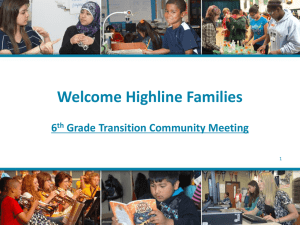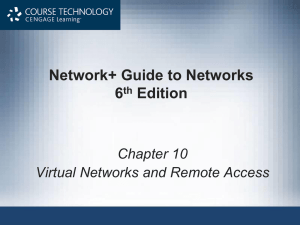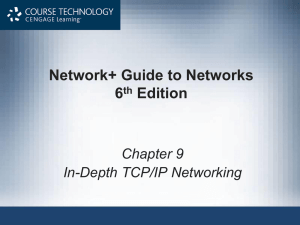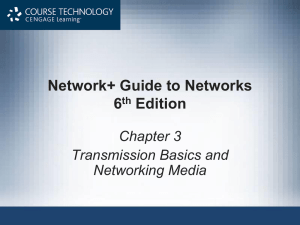Network+ Guide to Networks 6th Edition
advertisement
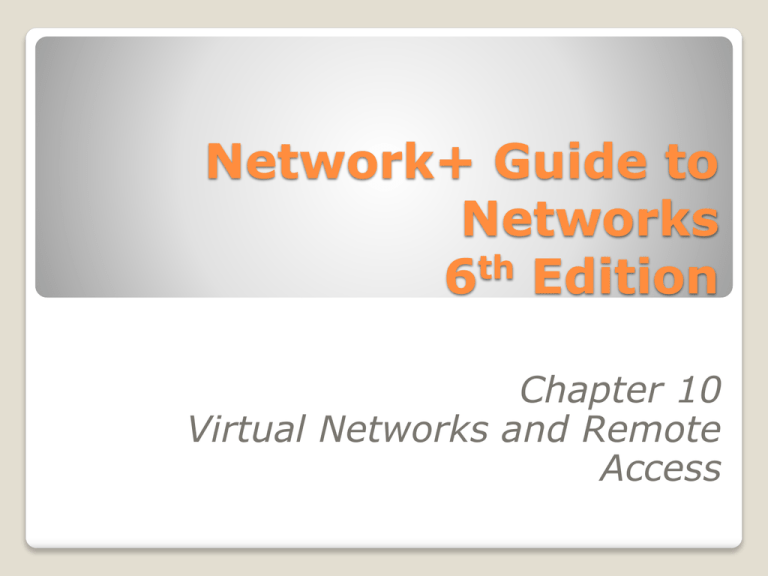
Network+ Guide to Networks 6th Edition Chapter 10 Virtual Networks and Remote Access Explain virtualization and identify characteristics of virtual network components Create and configure virtual servers, adapters, and switches as part of a network Describe techniques for incorporating virtual components in VLANs Explain methods for remotely connecting to a network, including dial-up networking, virtual desktops, and thin clients Objectives Network+ Guide to Networks, 6th Edition 2 Discuss VPNs (virtual private networks) and the protocols they rely on Identify the features and benefits of cloud computing and Objectives (cont’d.) Network+ Guide to Networks, 6th Edition 3 Emulation of a computer, operating system environment, or application: ◦ On a physical system Virtual machines (VMs) ◦ Virtual workstations ◦ Virtual servers ◦ Can be configured to use different types of: CPU Storage drive NIC Virtualization Network+ Guide to Networks, 6th Edition 4 VM appears to user no different than physical computer: ◦ Running the same software Host ◦ Physical computer Guest ◦ Virtual machines Hypervisor ◦ Manages virtual machines Virtualization (cont’d.) Network+ Guide to Networks, 6th Edition 5 Figure 10-1 Elements of virtualization Courtesy Course Technology/Cengage Learning Network+ Guide to Networks, 6th Edition 6 Advantages of virtualization ◦ ◦ ◦ ◦ Efficient use of resources Cost and energy savings Fault and threat isolation Simple backups, recovery, and replication ◦ ◦ ◦ ◦ Compromised performance Increased complexity Increased licensing costs Single point of failure Disadvantages Virtualization (cont’d.) Network+ Guide to Networks, 6th Edition 7 Virtualization program ◦ Assigns VM’s software and hardware characteristics ◦ Often easy to use, step-by-step wizard Operating system images ◦ Available for download online Or on disc from software vendors Network connection ◦ Requires virtual adapter (vNIC) Virtual Machines and Adapters Network+ Guide to Networks, 6th Edition 8 Figure 10-7 Selecting the Bridged option for a vNIC in VMware Courtesy Course Technology/Cengage Learning Network+ Guide to Networks, 6th Edition 9 NAT ◦ ◦ ◦ ◦ vNIC relies on host to act as NAT device Obtains IP addressing information from host Virtualization software acts as a DHCP server Default network connection type in VMware, VirtualBox, and KVM Host-only ◦ VMs on one host can exchange data with each other and the host ◦ Cannot communicate with nodes beyond the host ◦ Never receive or transmit data with host’s physical NIC Network Connection Types (cont’d.) Network+ Guide to Networks, 6th Edition 10 Figure 10-9 Selecting the NAT option for a vNIC in VirtualBox Courtesy Course Technology/Cengage Learning Network+ Guide to Networks, 6th Edition 11 Alternative to test servers for new software Virtual appliance includes: ◦ Image of operating system, software, hardware specifications, and application configuration Most commonly virtual servers Popular functions ◦ ◦ ◦ ◦ Firewall E-mail solutions Network management Remote access Virtual Appliances Network+ Guide to Networks, 6th Edition 12 Virtual network ◦ Refers to how VMs connect with other virtual and physical network nodes Virtual network management ◦ Nearly identical to physical network management Virtual Networks and VLANs Network+ Guide to Networks, 6th Edition 13 Remote access ◦ Allows user to connect with LAN or WAN in different geographical location ◦ Allows access to shared resources as any other client on LAN or WAN ◦ Requires transmission path and appropriate software Popular remote access techniques ◦ Dial-up networking ◦ Microsoft’s Remote Access Service (RAS) Or Routing and Remote Access Service (RRAS) ◦ Virtual Private Networks Remote Access and Virtual Computing Network+ Guide to Networks, 6th Edition 14 Dialing directly into private network’s or ISP’s remote access server Usually refers to connection using PSTN Remote access server attached to group of modems Client must run dial-up software After authentication, user allowed access Remote access server can serve multiple users Low throughput Less popular today Dial-Up Networking Network+ Guide to Networks, 6th Edition 15 Accepts connections regardless of Internet connection type RRAS (Routing and Remote Access Service) ◦ Microsoft’s remote access software ◦ Available with Server 2003, 2008, 2008 R2, XP, Vista, and 7 operating systems ◦ Enables server to act as a router ◦ Includes multiple security provisions Remote Access Servers Network+ Guide to Networks, 6th Edition 16 Figure 10-12 Clients connecting with a remote access server Courtesy Course Technology/Cengage Learning Network+ Guide to Networks, 6th Edition 17 SLIP (Serial Line Internet Protocol) ◦ ◦ ◦ ◦ ◦ Earlier and less sophisticated than PPP Can only carry IP packets Requires significant amount of setup Does not support data encryption Asynchronous transmission PPP (Point-to-Point Protocol) ◦ Known as PPPoE when used over Ethernet ◦ Standard for connecting home computers to ISP Via DSL or broadband cable Remote Access Protocols Network+ Guide to Networks, 6th Edition 18 Allows workstation to remotely access and control another workstation Host may allow clients a variety of privileges Can send keystrokes and mouse clicks to the host ◦ Receive screen output in return Thin client ◦ Workstation that uses such software to access LAN ◦ Requires very little hard disk space or processing power Remote Virtual Computing Network+ Guide to Networks, 6th Edition 19 Figure 10-13 Protocols used in a remote access Internet connection Courtesy Course Technology/Cengage Learning Network+ Guide to Networks, 6th Edition 20 Advantages ◦ Simple to configure ◦ Runs over any connection type ◦ Single host can accept simultaneous connections from multiple clients Popular programs ◦ Microsoft Remote Desktop ◦ VNC (Virtual Network Computing) ◦ ICA (Independent Computing Architecture) Remote Virtual Computing (cont’d.) Network+ Guide to Networks, 6th Edition 21 Remote desktop ◦ Comes with Windows client and server operating systems VNC (Virtual Network Computing) ◦ Open source system ICA (Independent Computing Architecture) ◦ Citrix System’s XenApp ◦ Can work with virtually any operating system or application ◦ Easy to use Remote Virtual Computing (cont’d.) Network+ Guide to Networks, 6th Edition 22 Logically defined networks over public transmission systems ◦ Isolated from other traffic on same public lines Requires inexpensive software Important considerations ◦ Interoperability ◦ Security Types ◦ Site-to-site ◦ Client-to-site VPNs (Virtual Private Networks) Network+ Guide to Networks, 6th Edition 23 Figure 10-14 Site-to-site VPN Courtesy Course Technology/Cengage Learning Network+ Guide to Networks, 6th Edition 24 Figure 10-15 Client-to-site VPN Courtesy Course Technology/Cengage Learning Network+ Guide to Networks, 6th Edition 25 Enterprise-wide VPN ◦ Can include elements of client-to-site and siteto-site models VPNs tailored to customer’s distance, user, and bandwidth needs Two major types of tunneling protocols ◦ PPTP (Point-to-Point Tunneling Protocol) ◦ L2TP (Layer 2 Tunneling Protocol) VPNs (cont’d.) Network+ Guide to Networks, 6th Edition 26 Internet frequently pictured as a cloud Cloud computing ◦ Flexible provision of data storage, applications, and services To multiple clients over a network Cloud computing distinguishing features ◦ ◦ ◦ ◦ ◦ Self-service and on-demand Elastic Supports multiple platforms Resource pooling and consolidation Metered service Cloud Computing Network+ Guide to Networks, 6th Edition 27 Figure 10-16 Example of cloud computing Courtesy Course Technology/Cengage Learning Network+ Guide to Networks, 6th Edition 28 Can provide virtual desktops ◦ Operating environments hosted virtually ◦ Different physical computer than one user interacts with NaaS (Network as a Service) ◦ Service provider offers customers complete set of networking services Types of delivery ◦ Public cloud ◦ Private cloud Cloud Computing (cont’d.) Network+ Guide to Networks, 6th Edition 29 Virtualization: emulation of a computer, operating system environment, or application on a physical system VMs exist as files on physical computer’s hard disk Hypervisor software manages resource allocation and sharing among virtual machines Virtual switch allows VMs to communicate with each other and with nodes on a physical LAN or WAN Different methods of remote user access exist Cloud computing provides storage, applications, or services over a network Summary Network+ Guide to Networks, 6th Edition 30



